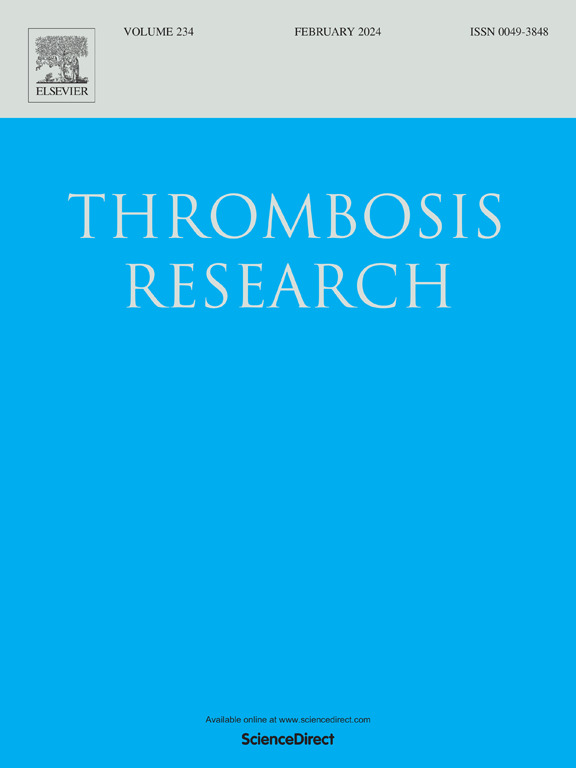慢性肢体威胁缺血中中性粒细胞胞外陷阱相关标志物-与进展和预后的关系
IF 3.4
3区 医学
Q1 HEMATOLOGY
引用次数: 0
摘要
背景中性粒细胞胞外陷阱(NETs)的形成参与动脉粥样硬化血栓形成,尽管人们对外周动脉疾病(PAD)中的这种现象知之甚少。我们研究了nets相关标志物是否与血管内治疗后PAD的严重程度和长期预后相关,以及它们是否影响纤维蛋白特性和凝血酶的产生。患者和方法我们研究了85例慢性肢体威胁性缺血(CLTI)患者在血管内治疗后一年内再狭窄和47例年龄性别匹配的PAD对照组无再狭窄。检测nets相关标志物,即循环瓜氨酸组蛋白H3 (H3cit)、髓过氧化物酶(MPO)、蛋白精氨酸脱氨酶4 (PAD4)、游离DNA (cfDNA)和DNA酶- i,以及纤维蛋白凝块通透性(Ks)、凝块溶解时间(CLT)、凝血酶生成和纤维蛋白溶解标志物。在随访期间,评估了包括再干预、截肢和死亡在内的复合终点。结果与对照组相比,CLTI合并再狭窄患者H3cit(59.8%)、MPO(58.4%)、cfDNA(35.3%)升高;所有p <;0.01)。Rutherford class与再狭窄组H3cit、MPO、PAD4、cfDNA呈正相关,与对照组H3cit呈正相关(均p <;0.05)。再狭窄组中Ks与H3cit、cfDNA呈负相关,而CLT仅与H3cit呈正相关(均p <;0.05)。在66个月的中位随访中,56例死亡患者(65.9%)的H3cit、MPO和cfDNA浓度高于幸存者(p <;0.05)。多变量分析H3cit、ETP、α2-抗纤溶酶和Ks是联合再干预、截肢和死亡的独立预测因子。结论:血管内治疗的PAD患者1年再狭窄风险和远期预后较差,与血栓原纤维蛋白凝块特性相关的nets相关标志物水平升高。本文章由计算机程序翻译,如有差异,请以英文原文为准。
Neutrophil extracellular traps-related markers in chronic limb threatening ischemia - a relation with progression and prognosis
Background
Neutrophil extracellular traps (NETs) formation is involved in atherothrombosis, though little is known about this phenomenon in peripheral artery disease (PAD). We investigated whether NETs-associated markers are related with the PAD severity and long-term outcomes after endovascular treatment and if they affect fibrin properties and thrombin generation.
Patients and methods
We studied 85 patients with chronic limb threatening ischemia (CLTI) and restenosis within one year after endovascular treatment and 47 age-sex-matched PAD controls without restenosis. NETs-associated markers, i.e. circulating citrullinated histone H3 (H3cit), myeloperoxidase (MPO), protein arginine deaminase 4 (PAD4), cell-free DNA (cfDNA) along with DNAse-I, together with fibrin clot permeability (Ks), clot lysis time (CLT), thrombin generation and fibrinolysis markers were determined. During follow-up a composite endpoint including re-intervention, amputation and death was assessed.
Results
Compared with the control group, patients with CLTI and restenosis had higher H3cit (59.8 %), MPO (58.4 %) and cfDNA (35.3 %; all p < 0.01). Rutherford class positively correlated with H3cit, MPO, PAD4 and cfDNA in the restenosis group and with H3cit in controls (all p < 0.05). In the restenosis group Ks negatively correlated with H3cit and cfDNA while CLT positively correlated solely with H3cit (all p < 0.05). At a median follow-up of 66 months, 56 patients who died (65.9 %) had higher H3cit, MPO and cfDNA concentrations than survivors (all p < 0.05). On multivariable analysis H3cit, ETP, α2-antiplasmin and Ks were independent predictors of combined re-intervention, amputation and death.
Conclusion
Higher levels of NETs-associated markers in relation to prothrombotic fibrin clot properties characterize endovascularly treated PAD patients at risk of 1-year restenosis and worse long-term outcomes.
求助全文
通过发布文献求助,成功后即可免费获取论文全文。
去求助
来源期刊

Thrombosis research
医学-外周血管病
CiteScore
14.60
自引率
4.00%
发文量
364
审稿时长
31 days
期刊介绍:
Thrombosis Research is an international journal dedicated to the swift dissemination of new information on thrombosis, hemostasis, and vascular biology, aimed at advancing both science and clinical care. The journal publishes peer-reviewed original research, reviews, editorials, opinions, and critiques, covering both basic and clinical studies. Priority is given to research that promises novel approaches in the diagnosis, therapy, prognosis, and prevention of thrombotic and hemorrhagic diseases.
 求助内容:
求助内容: 应助结果提醒方式:
应助结果提醒方式:


